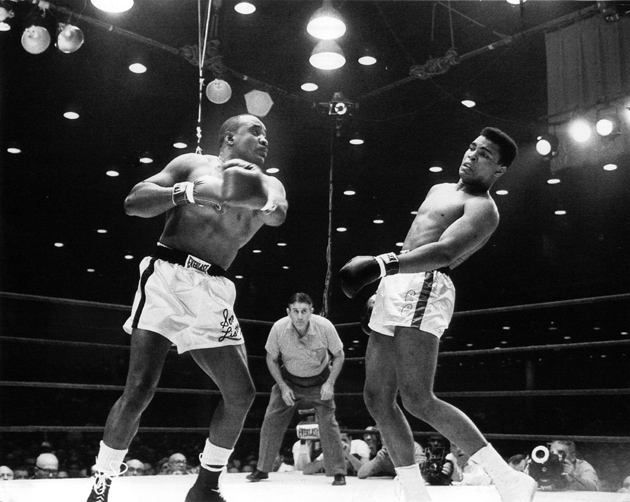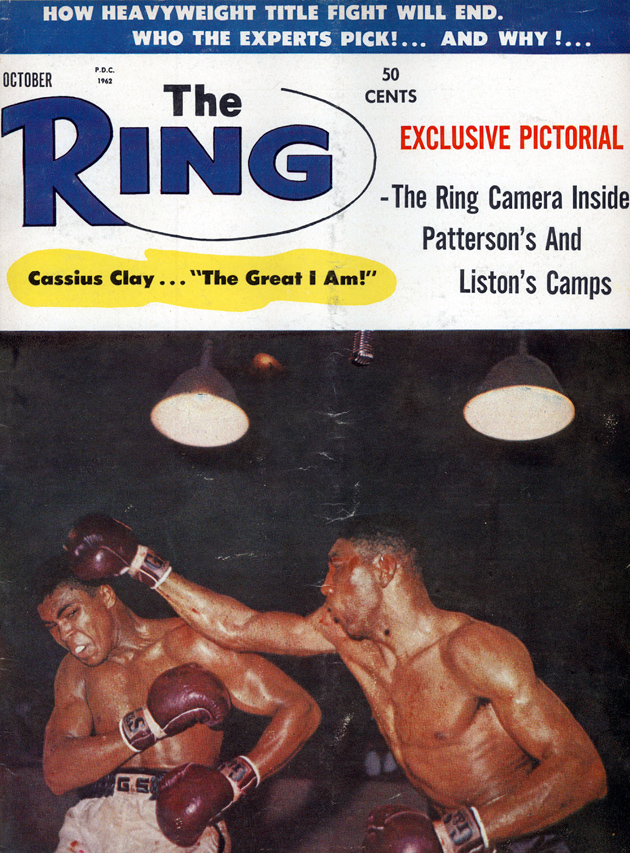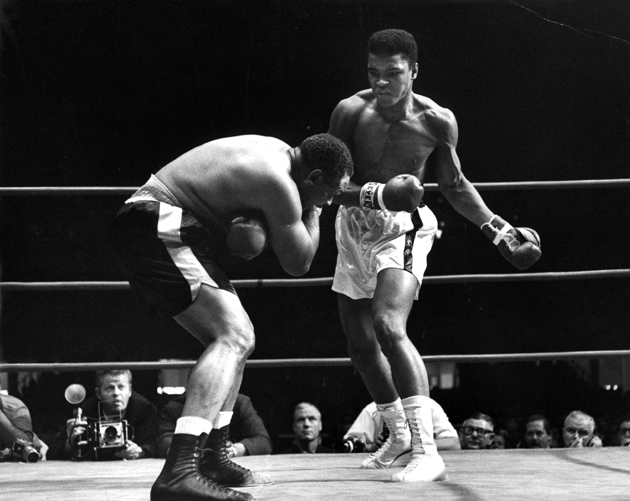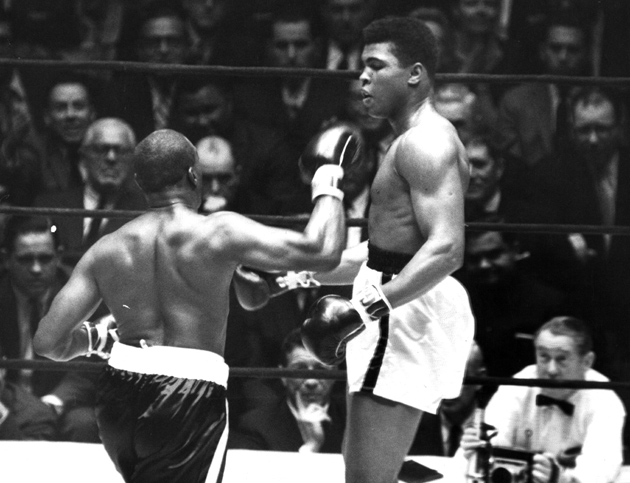Cassius Clay vs. Sonny Liston and the fights that molded a champion


Cassius Clay lands a straight right against fellow heavyweight contender Doug Jones during their 10-round bout at Madison Square Garden on March 13, 1963 in New York, N.Y. Clay, later known to the world as Muhammad Ali, won a hard-fought unanimous decision.
“Courage is grace under pressure.” – Ernest Hemingway
The fight was like a dream for the young Cassius Clay who, at 22 years of age, dethroned a terrifying heavyweight champion in Sonny Liston, before legally changing his name to Muhammad Ali and forging a path to greatness.
Clay was a 6-to-1 underdog at the Miami Beach Convention Hall and only he, and his corner team, headed by Angelo Dundee, truly realized the talent that the 1960 Olympic light heavyweight champion possessed.
From the moment Clay entered the ring, splendiferous in white trunks with a red stripe and black waist band, he glowed with destiny. His idol, Sugar Ray Robinson, introduced to 8,297 paid fans, climbed through the ropes and approached the young upstart with a smile.
Clay grabbed the legendary warrior’s hand and bowed exaggeratedly three times. I’ve learned Ray – now watch this.

In a dazzling exhibition of boxing Clay turned the feared, brooding, nightmarish Liston upside down. The champion swung from his home state of Arkansas, but Clay’s radar picked up the incoming bombs and guided him to safety.
Were Liston’s gloves “juiced” during the fight, as has been alleged? We’ll never know but Clay fought an entire round, the fifth, without the benefit of eyesight, only to rediscover his vision and hammer out a sensational seventh-round corner retirement (Liston didn’t come out for the seventh but the bell to begin the round had rung before the fight was stopped).
Over the years this upset has been hailed as one of the biggest in the sport, but on closer inspection one is struck by the amount of things the challenger had going for him. Younger, taller, faster but – perhaps more importantly – infinitely more active and battle hardened.
In the three years prior to this fight Liston had completed less than six professional rounds. A third-round knockout of journeyman Howard King was followed by first-round annihilations of Albert Westphal and Floyd Patterson (twice in title fights).
In sharp contrast Clay was extremely busy, taking part in over “eighty rounds” of combat within the same time frame and, in hindsight, several of these encounters were crucial in terms of physical, mental and technical development.
Tom Gray looks back at five fights which were instrumental in creating the elite level contender who “shook up the world”.
Cassius Clay TKO4 Sonny Banks – Feb. 1962, Madison Square Garden, New York City
Popular Mississippi native Sonny Banks had 10 wins out of 12 and, like Clay, was in his second year as a professional. There were no distinguished names on his ledger but, somewhat ominously, he had flattened nine of his victims, four in the opening round.
The warning signs were out.
A little more than a minute into Round 1 Clay trapped his opponent in a neutral corner and released a patented two-fisted assault. Banks remained composed, avoided the worst of it, and countered with a solid left hook to the jaw, which dropped Clay in an eye blink.
It was the first time the former Olympic star had been down as a professional, and he was up before the count could be administered, by acclaimed referee Ruby Goldstein. How would Clay react? Would he retreat in the face of danger?
Within seconds the young prospect fired back with a multi-punch salvo, but Banks hung tough and swung for the lights. He jarred Clay with another solid left in the second, but this time the response – a prolonged combination, punctuated by a crisp left uppercut – decked Banks at ring center.
The third was worse as Clay found his man with sizzling combinations. A triple right hand snapped Banks’ head back and a double left hook drove him across the ring. Clay was looking for the finish and there was no showboating or liberties. The young star was looking to hurt his opponent with immediate effect.
In the fourth Banks was reduced to throwing wild singles and when he tottered from a whipping left hook to the temple Goldstein elected to save him for another day. Clay had survived and Banks would forever be remembered as the first man to deck “The Greatest.”
Following the Clay encounter Banks had 11 more fights, winning eight, before signing on to meet talented Arkansas product Leotis Martin, who is best known for a spectacular knockout of Liston, in the former champion’s penultimate fight.
Banks versus Martin took place at the Philadelphia Arena on May 10, 1965, and was evenly contested until Round 9, when Martin caught his man with a sharp right to the temple. Banks dissembled and his head struck the canvas violently.
The 24 year old was counted out and, in the moments following the fight, lapsed in and out of consciousness. He was taken to hospital where surgeons attempted to remove a blot clot from his brain, but efforts to save his life failed.
Banks passed away three days later. Leotis Martin, distraught with grief, had visited his bedside.
Cassius Clay TKO7 Billy Daniels – May 1962, St. Nicholas Arena, New York City

Only three men lost their unbeaten records to Muhammad Ali – surprising but true.
The Greatest knocked out George Foreman (40-0) in 1974 to capture his second heavyweight championship, and outpointed Leon Spinks (7-0-1) in 1978, to win the back the WBA version of the title. The one you may not remember was a tough New Yorker named Billy “The Barber” Daniels (16-0).
On a scorching New York evening Daniels provided Cassius Clay with one very stern test.
At 189 pounds and 6-foot-4in tall “The Barber” would be an exceptionally well built cruiserweight today, but his physical attributes troubled Clay who, at 196 pounds, was still growing into the full-fledged heavyweight he would become.
After a confident opener, Clay was stung by a perfect straight right hand to the jaw in the second and the blow sent the sweat spraying under the ring lights. Crucially, as he had with Banks, the young Clay promptly nailed Daniels with a series of combinations, which cut the New Yorker around the left eye.
It was a fast pace and the two thoroughbreds, imitating the speed and athleticism of lightweights, mostly fenced at long range. Clay appeared to be getting the upper hand until Round 5, when he was hurt again by a sustained burst from Daniels, who attempted to close the show dramatically,
Clay survived, but he was having a torrid time.
Many felt Daniels was ahead but the wound around his eye was worsening. Veteran cut man Freddie Brown, from New Jersey, couldn’t stop the flow of blood and, his attempts to do so were constantly being thwarted by Clay, who switched from head hunter to eye hunter.
A few single shots pierced Daniels guard in the seventh and referee Mark Conn halted the action at 2:21 of that round. The crowd booed incessantly sensing that Clay was only three rounds away from suffering the first loss of his professional career.
Unfortunately for Daniels, the Clay bout and a split decision win over the highly respected Doug Jones were the highlights of his career. He seemed to go from unbeaten contender to journeyman overnight and suffered scores of losses to – among others – Joe Frazier, Jerry Quarry, Cleveland Williams, Zora Folley and Thad Spencer.
Clay and Daniels squared off in the old St. Nicholas’ Arena’s final televised boxing event. “The Rink” as it was affectionately known was rumored to have held almost 30,000 prize fights, from 1906, and was torn down to make way for an ABC television studio.
Cassius Clay TKO4 Archie Moore – Nov. 1962, Sports Arena, Los Angeles

This was the ultimate “Teacher vs. Student” confrontation. The ageless wonder Archie Moore, 45 years old, meeting Cassius Clay, two years prior to the birth of Bernard Hopkins, who would replace Moore as the current era’s version of a Father Time tormentor.
“The Old Mongoose” amassed a professional record of 185-23-10 and, with 131 knockouts to his credit, stopped more opponents than any man in history. The saying goes that records are made to be broken, but it is doubtful that any paid fighter will ever better Moore’s remarkable accomplishments.
The former light heavyweight champion’s history with Cassius Clay had been brief, but intimate. Prior to his second professional outing Clay, at the behest of his Louisville management team, was sent to California to train with Moore, who was without question one of the most knowledgeable boxing men on the planet.
Clay admired the light heavyweight icon, but the pair clashed when it came to business outside of the ring and cracks developed. Moore, a staunch disciplinarian, insisted that Clay prepare meals, wash dishes and clean up when training was over and the cocky 18 year old was incredulous at the request.
They parted ways before Clay had fought under Moore’s command. In later years “The Old Mongoose” acknowledged that he knew Clay was a gold mine, but pride and respect came first. When a fight between the pair was announced Moore was the “name” on the dance card, but the younger man was heavily favored to win and predicted a fourth round knockout.
Clay boasted, “I’ll sweep the old man out of the ring, because a good new broom sweeps up any old thing.”
The pre-fight pageantry in the arena was interesting. Special guest Sonny Liston, six weeks removed from his heavyweight title win, over Floyd Patterson, entered the ring to a raucous reception from a 16,000 strong Los Angeles crowd. Liston was popular? If that weren’t enough even Clay gave his future rival a respectful handshake.
Moments later legendary ring announcer Jimmy Lennon Sr. utilized incredible multi-tasking skills to not only introduce the fighters but he also gave a splendid rendition of The Star Spangled Banner.
Then the bell rang.
Clay’s punches came in rapid bursts and he shot them in any order he pleased. The young contender took chances, tattooed Moore at will and held off for the predicted fourth round finish. To this point in his career Clay had been accurate with ten of twelve predictions and this would be his eleventh successful fight call.
The shots coming back from Moore were in slow motion and, in round four, Clay let go with a speedy burst that had the veteran California dreaming before he hit the canvas. Two further knockdowns were academic and the bout was stopped by referee Tommy Hart.
“Archie Moore is my idol,” said Clay. “But I said he would go in four and now I want Liston – he’ll go in eight.”
Cassius Clay UD10 Doug Jones – March 1963, Madison Square Garden, New York City

What an interesting fighter Doug Jones was.
The highly skilled New Yorker turned professional in 1958 at middleweight, but raised hell in the glamour division with the body type of a puffed up light heavy. Jones won his first 19 bouts, posting knockout wins over the likes of former middleweight champion Bobo Olson and 1956 Olympic gold medalist Pete Rademacher.
After losing his first bout to Eddie Machen in December 1961 he was suddenly offered a crack at the light heavyweight championship of the world, which had been left vacant when Archie Moore permanently moved to heavyweight. Jones lost a 15 round decision in May 1962 and never campaigned at 175 pounds again.
A razor thin loss to the excellent Zora Folley was avenged by a stunning seventh round knockout in late 1962 and, in between those battles, Jones knocked out an unbeaten novice by the name of Bob Foster. Yes, the same Bob Foster who would go on to become one of the greatest light heavyweight champions in history.
Still, it was the Folley knockout which impressed and Jones, who had now broken the top ten, was closing in on a heavyweight title shot. The immensely talented Cassius Clay stood ominously in his path but Jones, who had mixed with some of the best fighters in the world, was far from intimidated.
Clay was returning to Madison Square Garden for the first time since the Sonny Banks scare, but this time a new problem arose. A newspaper strike meant the fight was getting zero publicity, so the young contender took it upon himself to visit as many radio and television studios as he possibly could.
Tickets sold out way in advance of fight night.
The bout itself produced plenty of action and too much of it was aimed towards Clay for his liking. He was stunned badly by a right hand in Round 1 and Jones matched him punch for punch throughout the 10 rounder. Clay dug deep in a memorable closing session, releasing scores of whipping shots to Jones’ head, but he had been tested and tested severely.
The judges all voted for Clay and the audience booed relentlessly.
In the1970s Muhammad Ali would get the benefit of the doubt, on official scorecards, more than once.
Jimmy Young, a cute defensive stylist from Philadelphia, barely absorbed a solid shot from Ali in a 1976 title bout, but still lost by unanimous decision in Landover, Maryland. If that verdict was open to debate then five months later the rubber match with Ken Norton, at Yankee Stadium, created an even bigger stir. Norton wept as the scorecards, which haunted him for years, were read out confirming Ali as the victor.
The win over Doug Jones was the only decision that Muhammad Ali, ne Cassius Clay, was awarded in the 1960s which was met by disapproval from a fight crowd. Was it a terrible decision? Was it a robbery? No, but it was arguably the finest night of Jones’ career and a performance that was not forgotten by boxing historians for decades to come.
Clay was asked at the post-fight press conference why he couldn’t make his prediction stick on this occasion and conveniently responded, “I called six, then I called four. Six and four is ten, right?”
Cassius Clay TKO5 Henry Cooper – June 1963, Wembley Arena, London, England
Was it one minute? Was it two? Was it 30 seconds?
Nobody ever provides the same answer on the amount of additional time Cassius Clay was accorded, between rounds, when Britain’s most beloved pugilist, Henry Cooper, nailed him with a jack hammer left hook to the jaw at the end of the legendary fourth.
Stan Courtney, the official timekeeper, stated that Clay was given 40 seconds, on top of the allotted one minute rest period, before the bell rang for Round 5. However, this reporter reviewed what was “listed” as an unabridged broadcast of the contest which suggests Clay received eight extra seconds.
The extended interval came about because legendary trainer Angelo Dundee noticed, and admittedly worsened, a tear in Clay’s glove to buy time. Subsequently his fighter was given vital seconds to recuperate, and that was unfair on Cooper, who earned the right to follow up on the most famous punch ever thrown in a British prize ring.
Still, let’s not dwell on it because the unprecedented build up to this 10 round non-title bout was only matched by a sensational scrap. In the summer of 1963 Clay’s overseas debut saw 35,000 spectators pile into the Wembley soccer stadium, with the hope that Henry’s Hammer would knock Clay out of his dancing boots.
Cooper weighed in at 185.5 pounds, whereas Clay, now beginning to fill out, was 207.
From the opening bell it was clear that the flashy American star had underestimated his opponent. Cooper pumped an effective left hand into his Clay’s face, busted him up on the inside, and bloodied his nose. It was without question the worst round of Clay’s career to date, and the British crowd was in frenzy.
The second round was quieter, but Clay became one of several fighters to draw blood, albeit sparingly, from Cooper’s eye. The British and Empire champion was a notorious bleeder, whose career was plagued with savage injuries to delicate orbital tissue, which looked as though it would succumb to hailstones, never mind punches.
True to type Cooper’s fragile skin betrayed him completely in the third and the blood began splashing off the ring canvas. Clay, who had respected his opponent five minutes earlier, now openly mocked him and began taking liberties, which outraged the home support.
The visitor carried his cocky demeanor in to the fourth and was very lethargic as the session drew to a close. Clay had been known to ease off if his predicted round was approaching, but this time he tempted fate with the wrong man.
Cooper’s signature left hook sent Clay’s eyes spinning into the back of his head and adversity confronted the American like a bounty hunter. The shot landing a second before the bell as well as Angelo Dundee’s intuitive, and illegal, ingenuity were invaluable blessings for the future legend.
Of course Clay bounced back to secure victory, widening Cooper’s wounds with brutal blows, and forcing referee Tommy Little to make the unenviable decision to stop the local hero in the predicted fifth. Still, foresight notwithstanding, “The Greatest” had his foundations rocked for the very first time in England and never forgot it.
The learning curve was complete and the exuberant Clay ventured back to his Miami Beach melting pot, the Fifth Street Gym, to prepare for the greatest challenge of his life – Charles “Sonny” Liston.
Photos / THE RING
Tom Gray is a member of the British Boxing Writers’ Association and has contributed to various publications. Follow him on Twitter: @Tom_Gray_Boxing














